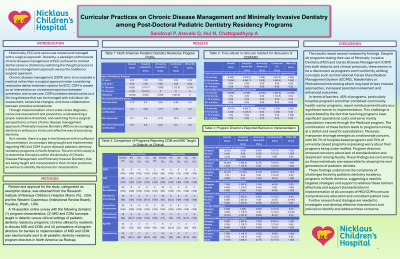Preventive
153 - Curricular Practices on Chronic Disease Management and Minimally Invasive Dentistry


Panagiota Sandoval, DDS (she/her/hers)
Dentist
Nicklaus Children’s Hospital, Miami, FL
Nicklaus Children's Hospital
Doral, Florida, United States- OA
Oscar Arevalo, DDS, ScD
Nicklaus Children's Hospital
- AC
Amit Chattopadhyay, PhD, MBA, MPH, FFPH-RCP, MDS
Nicklaus Children's Hospital
- NH
Nelson Hui, DMD, DMD
Private Practice
- OA
Oscar Arevalo, DDS
Program Director
Nicklaus Children's Hospital, Miami, Florida
Doral, Florida, United States
Presenting Author(s)
Co-Author(s)
Program Director(s)
Purpose: To assess curricular and clinical practices on Chronic Disease Management (CDM) and Minimally Invasive Dentistry (MID) taught and incorporated in Pediatric Dentistry Residency Programs (PDRP) in North America.
Methods: Program Directors - or the designee - were invited to participate via an online survey. The questionnaire included 19 items related to demographics, staffing, CDM and MID curricular and clinical practices and barriers to incorporation. Descriptive and inferential analysis including chi-square and Fisher’s exact tests were conducted.
Results: Twenty (20) PDRP completed full-surveys. The sample encompassed eleven (11) University-based, six (6) Hospital-based, three (3) combined University-Hospital, and one (1) other. All programs reported incorporating CDM and MID in both didactic and clinical protocols. Regarding didactics, 30% did not teach the International Caries Classification and Management System (ICCMS), 35% did not teach Lesion Activity Assessment (LAA), and 40% did not teach Teledentistry. Regarding clinical protocols, 25% did not utilize Motivational Interviewing, 35% did not incorporate Teledentistry, and 60% did not utilize the ICCMS. When queried about barriers to incorporation of CDM and MID, 65% of programs reported concerns about reimbursement / costs, 55% reported their programs were under-staffed, 50% reported faculty skepticism, and 45% reported a lack of standardization among faculty.
Conclusion: Although all programs reported incorporating CDM and MID into both didactic and clinical protocols, there is considerable variation on the depth and scope of topics taught and strategies incorporated. Enhancing reimbursement, increasing the scope of concepts, and standardizing faculty members should enhance outcomes among the pediatric patient populations served.
Identify Supporting Agency and Grant Number: Research supported by the Health Resources and Services Administration (HRSA) of the U.S. Department of Health and Human Services (HHS) as part of an award totaling $449,999, with 55 percent financed with nongovernmental sources. The contents are those of the author(s) and do not necessarily represent the official views of, nor an endorsement by, HRSA, HHS, or the US government. For more information, please visit ww.HRSA.gov.

.jpg)